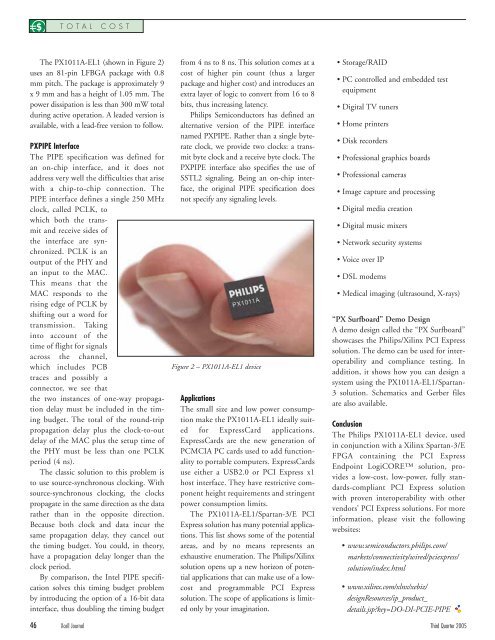Design Challenges: Avoiding the Pitfalls, winning the game - Xilinx
Design Challenges: Avoiding the Pitfalls, winning the game - Xilinx
Design Challenges: Avoiding the Pitfalls, winning the game - Xilinx
Create successful ePaper yourself
Turn your PDF publications into a flip-book with our unique Google optimized e-Paper software.
$<br />
TOTAL COST<br />
The PX1011A-EL1 (shown in Figure 2)<br />
uses an 81-pin LFBGA package with 0.8<br />
mm pitch. The package is approximately 9<br />
x 9 mm and has a height of 1.05 mm. The<br />
power dissipation is less than 300 mW total<br />
during active operation. A leaded version is<br />
available, with a lead-free version to follow.<br />
PXPIPE Interface<br />
The PIPE specification was defined for<br />
an on-chip interface, and it does not<br />
address very well <strong>the</strong> difficulties that arise<br />
with a chip-to-chip connection. The<br />
PIPE interface defines a single 250 MHz<br />
clock, called PCLK, to<br />
which both <strong>the</strong> transmit<br />
and receive sides of<br />
<strong>the</strong> interface are synchronized.<br />
PCLK is an<br />
output of <strong>the</strong> PHY and<br />
an input to <strong>the</strong> MAC.<br />
This means that <strong>the</strong><br />
MAC responds to <strong>the</strong><br />
rising edge of PCLK by<br />
shifting out a word for<br />
transmission. Taking<br />
into account of <strong>the</strong><br />
time of flight for signals<br />
across <strong>the</strong> channel,<br />
which includes PCB<br />
traces and possibly a<br />
connector, we see that<br />
<strong>the</strong> two instances of one-way propagation<br />
delay must be included in <strong>the</strong> timing<br />
budget. The total of <strong>the</strong> round-trip<br />
propagation delay plus <strong>the</strong> clock-to-out<br />
delay of <strong>the</strong> MAC plus <strong>the</strong> setup time of<br />
<strong>the</strong> PHY must be less than one PCLK<br />
period (4 ns).<br />
The classic solution to this problem is<br />
to use source-synchronous clocking. With<br />
source-synchronous clocking, <strong>the</strong> clocks<br />
propagate in <strong>the</strong> same direction as <strong>the</strong> data<br />
ra<strong>the</strong>r than in <strong>the</strong> opposite direction.<br />
Because both clock and data incur <strong>the</strong><br />
same propagation delay, <strong>the</strong>y cancel out<br />
<strong>the</strong> timing budget. You could, in <strong>the</strong>ory,<br />
have a propagation delay longer than <strong>the</strong><br />
clock period.<br />
By comparison, <strong>the</strong> Intel PIPE specification<br />
solves this timing budget problem<br />
by introducing <strong>the</strong> option of a 16-bit data<br />
interface, thus doubling <strong>the</strong> timing budget<br />
from 4 ns to 8 ns. This solution comes at a<br />
cost of higher pin count (thus a larger<br />
package and higher cost) and introduces an<br />
extra layer of logic to convert from 16 to 8<br />
bits, thus increasing latency.<br />
Philips Semiconductors has defined an<br />
alternative version of <strong>the</strong> PIPE interface<br />
named PXPIPE. Ra<strong>the</strong>r than a single byterate<br />
clock, we provide two clocks: a transmit<br />
byte clock and a receive byte clock. The<br />
PXPIPE interface also specifies <strong>the</strong> use of<br />
SSTL2 signaling. Being an on-chip interface,<br />
<strong>the</strong> original PIPE specification does<br />
not specify any signaling levels.<br />
Figure 2 – PX1011A-EL1 device<br />
Applications<br />
The small size and low power consumption<br />
make <strong>the</strong> PX1011A-EL1 ideally suited<br />
for ExpressCard applications.<br />
ExpressCards are <strong>the</strong> new generation of<br />
PCMCIA PC cards used to add functionality<br />
to portable computers. ExpressCards<br />
use ei<strong>the</strong>r a USB2.0 or PCI Express x1<br />
host interface. They have restrictive component<br />
height requirements and stringent<br />
power consumption limits.<br />
The PX1011A-EL1/Spartan-3/E PCI<br />
Express solution has many potential applications.<br />
This list shows some of <strong>the</strong> potential<br />
areas, and by no means represents an<br />
exhaustive enumeration. The Philips/<strong>Xilinx</strong><br />
solution opens up a new horizon of potential<br />
applications that can make use of a lowcost<br />
and programmable PCI Express<br />
solution. The scope of applications is limited<br />
only by your imagination.<br />
• Storage/RAID<br />
• PC controlled and embedded test<br />
equipment<br />
• Digital TV tuners<br />
• Home printers<br />
• Disk recorders<br />
• Professional graphics boards<br />
• Professional cameras<br />
• Image capture and processing<br />
• Digital media creation<br />
• Digital music mixers<br />
• Network security systems<br />
• Voice over IP<br />
• DSL modems<br />
• Medical imaging (ultrasound, X-rays)<br />
“PX Surfboard” Demo <strong>Design</strong><br />
A demo design called <strong>the</strong> “PX Surfboard”<br />
showcases <strong>the</strong> Philips/<strong>Xilinx</strong> PCI Express<br />
solution. The demo can be used for interoperability<br />
and compliance testing. In<br />
addition, it shows how you can design a<br />
system using <strong>the</strong> PX1011A-EL1/Spartan-<br />
3 solution. Schematics and Gerber files<br />
are also available.<br />
Conclusion<br />
The Philips PX1011A-EL1 device, used<br />
in conjunction with a <strong>Xilinx</strong> Spartan-3/E<br />
FPGA containing <strong>the</strong> PCI Express<br />
Endpoint LogiCORE solution, provides<br />
a low-cost, low-power, fully standards-compliant<br />
PCI Express solution<br />
with proven interoperability with o<strong>the</strong>r<br />
vendors’ PCI Express solutions. For more<br />
information, please visit <strong>the</strong> following<br />
websites:<br />
• www.semiconductors.philips.com/<br />
markets/connectivity/wired/pciexpress/<br />
solution/index.html<br />
• www.xilinx.com/xlnx/xebiz/<br />
designResources/ip_product_<br />
details.jsp?key=DO-DI-PCIE-PIPE<br />
46 Xcell Journal Third Quarter 2005

















